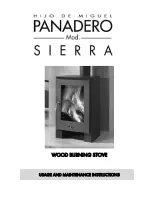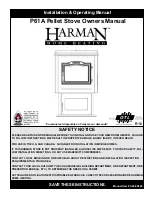
Exception TL200 W ood Stove
10
The Chimney System
Creosote
When wood is burned slowly, it produces tar and
other organic vapors, as well as soot, which combine with
expelled moisture to form creosote . The creosote vapors
condense in the relatively cool chimney flue (associated
with a slow burning fire). As a result, creosote accumu-
lates on the flue lining. When ignited, this creosote can
result in an extremely hot fire.
The Afterburner on the Exception cuts creosote to
almost nothing when properly burned with dry seasoned
wood.
The chimney should be inspected at least once
every two months during the heating season to see if any
creosote build-up has occurred. Checking your chimney
and chimney connector more frequently, especially while
you are getting used to your stove, is recommended. To
inspect this system, let the stove cool. Using a flashlight
and mirror, check the interior of the chimney connector,
and the chimney itself. If a significant layer of creosote or
soot as accumulated (1/8"” or 3 mm) it should be removed
to reduce the risk of a chimney fire.
To clean deposits from the surface of the connec-
tor, use a stiff wire brush after dismantling the connector
assembly. To clean the chimney, use a specially designed
brush sized to fit your particular flue opening, or call an
established chimney cleaning service.
At the end of the heating season, perform a thor-
ough examination of your chimney system, and have it
repaired if necessary.
Gaskets
Gaskets are used at strategic positions when build-
ing the Harman Exception for controlling the path that in-
coming and outgoing air and gases take through the stove.
You must check these gaskets from time to time, and
replace them when necessary. The gaskets are made of
fiberglass of different sizes (obtainable from Harman Stove
Company) and are fixed in place with a high temperature
stove gasket cement. To change a gasket, first remove
the worn fiberglass and clean the area with a wire brush.
Also clean any other surfaces that come into contact with
the gasket. Place a small bead of cement in the area
under the gasket, then press new gasket material into the
channel; do not overlap the ends of the gasket. Seat the
gasket firmly by applying pressure when possible; for ex-
ample, after changing the door gasket, close the door. Allow
the cement to dry before using your stove.
Gaskets are located:
•
On the doors to provide airtight closure.
•
Between the damper and the damper frame.
Handle
The handle on the front door of your Exception is
attached to a threaded shaft. After a period of time, you
may find that the front door does not close as firmly as
when your stove was new. This is due to a natural com-
pression of the gaskets. To tighten the seal, open the
door and rotate the handle one full turn counterclockwise
or bend the latch plate on the stove.
Blower
The optional blower on your Harman Exception
stove requires very little maintenance. You should, how-
ever, keep the air inlet and the motor free of dust and dirt.
Maintenance









































